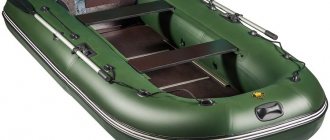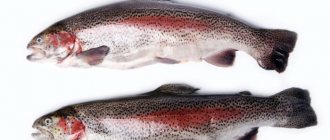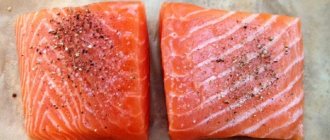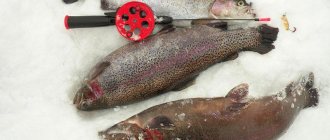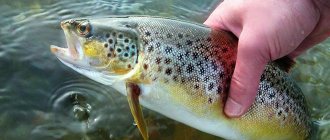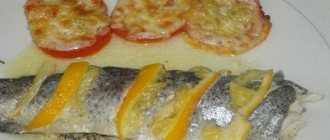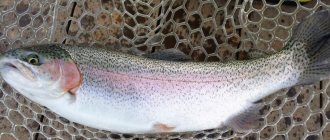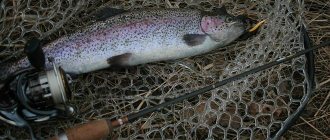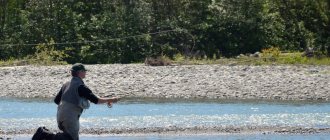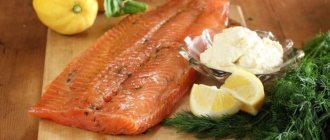Nowadays, trout fishing in winter using girders on paid and wild ponds is gaining an increasing number of adherents to this fishing. You can catch fish not only with this equipment, but also with other promising fishing devices for ice fishing.
Trout is a beautiful fish that can be caught on a girder, but should be released as soon as possible
Advantages and disadvantages of trout fishing on girders
Using a girder for winter trout fishing has many advantages:
- no need to buy expensive artificial bait;
- ease of use;
- recreational infrastructure has been developed at paid ponds;
- high efficiency of the gear.
But winter trout fishing also has disadvantages:
- fine tuning of the equipment is required, since the fish spits out the bait if it senses danger;
- it is difficult to determine the depth where the trout are located;
- on paid ponds there are often restrictions on the number of installed girders.
Trout fishing is not much different from zander and pike
Where to look for trout in a pond
Fish live in any place of a certain body of water. During the dead of winter, aerators are installed at many paid stations to saturate the water with air, since trout are sensitive to the presence of oxygen in the pond. Fishing near these devices is much more promising, although some anglers claim that fish that live far from this equipment are much more active.
It’s easier to find trout parking spots on a paid site
Recommendation: The main difficulty is determining the depth where the fish are located. If when fishing with artificial bait it is possible to examine all water layers, then the bait on a permanently located girder is often located outside the location of the trout school. Therefore, it is worth installing a whole range of supplies, breaking through the entire promising horizon at once.
As a rule, trout ply not near the bottom, but in the floor of the water, however, with a significant depth of the reservoir, it is very difficult to determine the required horizon. That’s why they usually combine fishing with active baits and girders. Thanks to the artificial nozzle, you can determine the water layer for trout fishing and lower the fishing line on stationary stands to the required depth.
Types of girders
Trout, unlike other predatory fish, at any suspicion of danger, spits out the bait, so the fishing line must be adjusted to leave the girder in such a way that the fish does not feel any resistance. Therefore, in addition to traditional models on the platform, other structures are often installed.
The best trout girders that can be installed in winter:
- IN American version The spool is under water, so the line can come off easier. However, in our country this equipment is not popular because of its high cost, as well as because of its complex design, which makes installation much more difficult, and because of the inconvenience of fishing during severe frosts.
American supplier - Changeling Priest. You can build this installation of a girder for winter fishing with your own hands. The equipment is quite sensitive, and the line easily flies off the reel, which is why trout often hook themselves.
Changeling supply - Delivery. At the heart of this equipment is a rod, which is used to catch fish in an active way. It is mounted on a specially made stand. This rod needs to be watched, and when the tip drops, a hook needs to be made.
Design of the vent
As a rule, fishermen use the classic options with a base and a signaling flag, since these designs are available in any fishing store, they are not expensive, and installation is very simple.
The standard arrangement of a rainbow trout rig looks like this:
- Reel _ It is installed on a stand and secured with a bracket. What is required from this element of equipment is that the reel can rotate easily and have a large spool size. Often fishermen paint half the reel in a contrasting color, which allows them to see the spool dropping line from a distance.
- Base. Most often it is made of plastic and has the shape of a circle. A stand with a reel and a flag are fixed to the base, which plays the role of a signaling device. There is also a radial slot in the platform through which the fishing line is passed.
The flag lights up - run to the girder, but we’re not in a hurry to make a sweep - Lesk A. Most often, winter fishing line with a cross-section of 0.20-0.25 mm is chosen for trout. There must be at least 25 meters on the spool.
- Checkbox . Typically made from a clock spring. A red flag made of waterproof material is installed at the tip.
- Hook . Basically, when fishing for trout, single hooks number 4-8 are installed.
- Leash . Its length should be no more than 0.5 meters, it is made of fluorocarbon with a cross-section of 0.16-0.18 mm. The diameter will depend on the weight of the intended trout.
- Small weight . For this purpose, a sliding pellet with a weight that is as low as possible is used.
Horizontal girder - supply for winter fishing
Tackle for trout fishing with spinning rod
The most interesting tackle for trout fishing is a spinning rod. There is no need for special skill here; it is enough to select all the elements of the equipment correctly and competently. Spinning fishing is an interesting and exciting activity because it is very simple and effective.
As for experienced fishermen, they have long ago decided on their gear and are armed with several rods for various purposes and designed for trout fishing in any conditions. As for beginning spinning anglers who decide to master this tackle, the answer is ambiguous. Still, despite its ease of use, each fishing trip is fraught with certain secrets that are revealed as you gain experience. Therefore, to begin with, it makes sense to purchase a fishing rod after consulting with an experienced, familiar spinning player. Although everything is relative and everyone, even an experienced fisherman, has his own fishing rod to which he is accustomed. But this does not mean at all that another angler will like such a rod.
Rod
This element of gear is selected depending on the specific fishing conditions. If you are using a rod for fishing from a clean shore, you can take a blank about 3 meters long. If there are thickets on the shore, then a long rod creates certain inconveniences. And when fishing from a boat, you can only use a short rod, since there is no need for long casts, especially when trolling.
If fishing is carried out on the same body of water, then problems with determining the length should not arise. If fishing is done in various, unfamiliar bodies of water, then you should take a rod 2.4 m long. It may well be suitable for various conditions, although not 100%.
Spinning test
As a rule, trout are caught with bait weighing about 7 g and no more. This means that the test of the rod should be in the range of 0-7 g or 2-7 g. In extreme cases, up to 10 g. Rods with such a test are ultralight rods. The action of the blank can be fast, although with such a rod you need to be able to catch fish such as trout. The fact is that the trout seriously resists, and a rigid rod is not able to fully extinguish its jerks.
A rigid spinning rod allows you to better control the wiring process. If you take a slow action rod, it will allow you to cast a small bait further, but it does not have the sensitivity that a fast action rod has.
When fishing for trout, the sensitivity of the rod is very important, so it is better to buy high-quality, but cheap blanks. Naturally, you can also find quite expensive models, but not every angler can afford them.
Therefore, you need to choose something in between, but it’s better not to take cheap rods. Fishing is interesting because you have the opportunity to enjoy catching this interesting fish. Interest in fishing will disappear as soon as the stick breaks into several pieces.
fishing line
An equally important element of gear that directly affects sensitivity. A braided line can very quickly transfer a bite to the tip of the rod. In addition, it is more reliable than monofilament, therefore, you can equip the tackle with a thinner fishing line
This is very important when casting light-weight lures. The thinner the line, the farther you can cast the ultralight bait
Line diameter
If monofilament fishing line is used, then its diameter should not exceed 0.18 mm, and when choosing braid, you can choose a diameter of 0.12 mm, but not less.
Coil
When choosing a reel, you should take into account the action of the rod. If a rigid rod is used, then the reel must have a reliable, high-quality clutch. This is necessary so that the reel also participates in the process of landing fish, otherwise it will be difficult to cope with trout. At the same time, the friction brake must be adjusted to a certain weight of the fish, taking into account the thickness of the fishing line. Then the powerful jerks of suitable specimens will be smoothed out. As for small specimens, there are no particular problems when catching them.
In order for the fish to get closer to the angler faster, you should choose a reel with a high gear ratio. These characteristics correspond to reels with a gear ratio of 5:1.
Trout fishing. Choosing gear.
Watch this video on YouTube
Baits used
The most common bait used is shrimp. To equip a girder with a boiled frozen bait, it is enough to place its tail on the hook. There is no need to remove the shell. In addition to shrimp, the following baits are possible for equipping a trout supply:
- maggot;
- iris catching paste;
Trout paste - bloodworm;
- pieces of fish fillet;
- worm;
- live bait
Recommendation: Basically, bleak or perch about 4-6 cm in size are used as live bait.
Equipment for vents
Sinkers, fishing line and hooks
When equipping rigs, I recommend using an olive sinker of such a size that the sinker fits freely into the groove of the reel and not by tension. This will make it easier for you to unwind the beginning of the tackle when installing it. The required weight is obtained by the number of olives.
I use two 3/8 oz olives.
The sinkers are fixed with two stoppers cut from the cargo inner tube.
The line is threaded through the stopper using a thin saddlery awl. The loop knot is covered with a cambric, this protects the line from getting caught behind the knot and getting tangled. A 20-30 cm piece of cord (0.4 mm in diameter or more) is attached to the loop of the fishing line with a noose loop - the cord protects the fishing line from rubbing against the edge of the hole when placing the head of a trophy fish into the hole. Often it is Trophies who lead long round dances, the tension under the hole and the fishing line are in the risk zone... The other end of the cord is also attached to the swivel of the leash with a noose loop. This installation makes it possible to quickly replace the leash in case of chronic wear.
For fishing with girders, I only use doubles.
This is due to the method of attaching live bait, which I successfully practice, and, again, to promptly removing the hook from the leash. The main line is attached to the reel using a self-tightening loop.
Winding fishing line - video
Since winding the fishing line on this model of girder is done somewhat non-standardly, I decided not to talk about it, but to show it.
In words:
- Thread the fishing line from top to bottom into the “Anti-Beard” hole
- Tie the fishing line to the reel with a self-tightening loop, or any other knot that you prefer.
- Wind the fishing line (move the reel clockwise, respectively, the fishing line counterclockwise)
- Equip the vent.
- The concept of the Anti-Beard is to make one turn of the line counterclockwise around the reel and lower the sinkers and live bait into the hole.
Live bait and its bait on the hook
Dear Friends, use a fixed net for catching live bait only as a last resort, when there is no other alternative. After the net, live bait is no longer live bait, but dead fish and is most suitable for fishing in Pike traps. In fact, they sometimes hang frozen food on traps.
There are countless ways to attach live bait to a hook (single, double, treble), from simple and practical to almost sexually perverted. The method described below involves the use of a double, and was shown to me by old Fishermen in the Tomsk region.
Having removed the double from the leash, the loop of the leash is carefully passed under the gills of the live bait and the leash is pulled out through the mouth
The double is threaded through the loop of the leash and the leash is carefully pulled up. The double depicts a mustache on the muzzle of a live bait fish
What is good about this method of attaching live bait? I will answer in detail point by point:
- Live bait is not injured and remains mobile for a long time.
- When you see a fresh job, you don’t need to run like crazy, your eyes bulging, to the line and hook! It is well known that Pike always grabs live bait across the body, swims with it for some distance and there begins to swallow it from the head. From the head, that’s right, from the Head!.., and there is a double – “with its stings back”..., so the Fish, without being pierced, calmly swallows the bait. With this method of attaching live bait, I have never had any problems. (Ugh, ugh, ugh!!) Of the hundreds of different-sized Shchukans, only a few had a hook in the jaw, a dozen had a hook in the gills, and all the rest had a hook in the beginning of the esophagus.
- Based on the above, when you see a fresh piece of work, do not run to it, but take out a flask with Cognac. Take a sip for a Happy Day in Nature! Take a deep breath of the frosty air... And then, slowly, take a replacement eland with live bait and a hook, go to work, I wish you that there would be a lot of them...
I would like to emphasize to you: Take your time! Let the Pike swallow it... And enjoy your Rest and Fishing!
Self-production of the girder
Usually, the installation of a girder when fishing for winter trout is done in a classic way. This device has excellent resistance to strong winds and does not allow the hole to freeze, although the assembled size is quite bulky.
How to make a zherlitsa correctly - step-by-step instructions:
- The base is cut out of a plywood sheet using a hacksaw. It is not necessary to make a round shape.
- A hole is made in the base for the fishing line. A stand made of angle steel is installed and fixed to the platform using self-tapping screws.
- A bracket is made from a spoke from a bicycle wheel.
- The coil on the bracket is fixed to the base.
- The reel can be made from a regular reel spool.
- A bite alarm is made from a watch spring.
- At the end, a red flag is fixed.
- The fishing line is wound onto the spool.
- The weight is being threaded.
- A swivel with a carabiner is attached to the end of the fishing line. The design of the girder for fishing in the current
- A leash is knitted with a hook and fixed to the main line using the “loop-to-loop” method.
Homemade winter trout girder
How to make a trout vent with your own hands
Making a trout girder yourself is not as difficult as it might seem. Most often, fishermen resort to the classic type. Their advantage is good stability in gusts of wind and do not freeze to the hole.
The algorithm of actions is as follows:
- Using a hacksaw, you need to cut a platform of a suitable size from plastic or foam. The shape must be round.
- A slot is made in the prepared platform for threading the fishing line.
- The stand is made of metal corners, which are attached to the stand using self-tapping screws.
- A spoke from a bicycle wheel is perfect for the bracket.
- The reel is attached to the stand using brackets.
- The reel is made from an empty spool (from fishing line).
- A bite alarm can be made from wire or a watch spring.
- A red rag flag is attached to the end of such a signaling device.
- The line is wound onto a reel.
- The sinker is fixed on the fishing line.
- A swivel with a special fastener is attached to the free end of the fishing line.
- Make a leash by tying a hook to it using a clinch knot.
- The leash is attached to the main fishing line.
It is important to make sure that the vent can be easily disassembled if necessary, which is convenient for storage.
Installation Features
To correctly install the vent, you need to follow the following steps:
- a hole is drilled;
- pieces of ice are removed;
- the depth is measured, preferably using a depth gauge;
- equipment is assembled;
- the required length of fishing line is wound, which, according to the fisherman, is optimal for successful catching of fish;
- attach bait to the hook;
- the tackle is lowered into the water;
- The hole is slightly covered with snow.
Girder equipment and trout fishing in winter on supplies:
Fishing tactics
Today, owners of paid trout reservoirs allow fishing with a limited number of equipment, while in Europe it is often allowed to install only one girder. Therefore, the gear needs to be installed correctly, due to their small quantity.
Trout swims in the pond all the time; you can catch it in almost any part of the reservoir. If possible, then you should focus on other fishermen.
Most often, trout is caught in several ways:
- They keep an eye on the girders all the time;
- They set up the fishing rods and go fishing with lures.
With the first method, the chances of catching trout on a girder are small, since the fish are not often hooked on their own. But you can take a predator on artificial bait, which is much more exciting. The strategy for catching fish on girders consists of periodically rearranging equipment and changing water layers to determine the location of trout. It is worth trying out different baits, since the food preferences of fish are unpredictable.
What to do during a bite? You shouldn’t expect the fish to swallow the bait well, taste it, and then leave with it. When the trout has exhausted about 50 cm of fishing line, you need to urgently hook. Trout is a very neat and delicate fish, and therefore you should not wait long.
You need to fish for fish carefully, without forcing things, and at the same time, do not loosen the fishing line. This predator has quite dense lips, and the hook is securely in them, but strong trout often breaks the fishing line, and if there are stones at the bottom, then the fish will most likely go to this place and it will not be easy to pull it out.
Fishermen who are accustomed to catching small perch or small pike do not even know how strong the trout themselves are. Therefore, the hook must always be at hand, and a hole measuring 150 mm sometimes turns out to be very small in order to easily get fish out of it. At the same time, often in one pond there are trout of various sizes, and among the kilogram sizes, sometimes there is a “three trout”, the fisherman must definitely prepare for this.
Fishing for trout on a paid reservoir using girders and supplies:
Also, when fishing for trout, you need to be very careful and not make unnecessary noise. Fish can easily become frightened, leaving even their habitable areas or places to search for food. The noise is often caused not only by the fisherman, but also by the caught trophy.
A predator hooked on the bait actively tries to leave, thereby scaring away the entire flock. In order not to scare the iris, you need to fish it out as quickly as possible. Why do you need a fishing line that will allow you to do this?
Gear selection
Having figured out how to make a bait donkey, you need to move on to the baits and lures that are best to use. As for baits, they can be plant or animal - it’s clear what this relates to.
If we talk about the main baits that are used when using donka, then these are makukha, live bait, peas, maggots or worms. These baits are good because they don’t jump off the hook when casting.
Experienced fishermen recommend paying attention not only to the delicacy, but also to the color of the hook, which should match the color of this delicacy
For biting, experienced fishermen advise using two types of shellfish:
- Crangon is a small sandy crustacean of gray-green color.
- Palemon is a large sea dweller with a translucent shell.
https://youtube.com/watch?v=sb26YlkBcOA
The cleaned white meat from the tail section holds best on the hook. Many fishermen attach it to the very end so that it oscillates and attracts fish.
However, other parts of the mollusk's body can be used. They are pinched off and slightly tousled to enhance the smell.
If there is a rare bite, it is recommended to change the fishing shrimp often so that it does not lose its attractiveness after being in the water for a long time.
There is nothing special about fly fishing gear, although many consider it inconvenient and difficult to use. The only thing that is required of a person is to accurately cast the bait, and preferably far.
As a rule, fly fishing is mastered in a few days of training. In addition, the tackle has its own characteristics related to its design and purpose.
And here it is very important to correctly select all the elements of the gear.
Rod
If we talk about wild bodies of water, it is difficult to find areas on the shore where there is no vegetation. Therefore, you have to select a form for specific conditions.
Fly fishing class
Fly fishing gear is divided into classes. For trout fishing, gear of 3-7 classes is quite suitable. For beginner fishermen, we can recommend 5th class gear. This is a middle class: the tackle is not light, but not heavy either.
Leash
This element of gear has its own characteristics. The length of the leash is selected depending on the length of the rod: if the length of the rod is 2.4 meters, then the length of the leash should be the same - 2.4 meters.
At the same time, the thickness of the leader decreases towards the bait. To do this, the leash is divided into 4 parts and each section is tied together using fishing line of different diameters.
For example, a leash 2.4 meters long is divided into 4 parts and we get 4 segments, each 0.6 meters long. Now each segment has its own fishing line.
For example, the first segment, 0.6 m long, which is located closer to the end of the rod, consists of a fishing line 0.35 mm thick. The second segment is 0.24 mm, the third segment is 0.18 mm and the last segment to which the bait is attached is 0.14 mm.
As a result, it turns out that at the end of the rod there is the thickest piece of fishing line, and near the bait - the thinnest
It is very important to tie all the segments with high-quality and reliable knots
Video “Tackle for fly fishing for trout”
The thickness of the fishing line ranges from 0.2 to 0.25 mm and depends on the size of the trout that is caught on the hook. Hooks No. 6-8 are quite suitable for fishing. Since trout is a cautious fish, it is not recommended to tie more than one hook to the tackle. When fishing for trout, a leash about 20 cm long is used.
A reel with a drag, on the spool of which about 50 meters of fishing line is wound, would not hurt. This will allow you to pull out any trout specimen.
Video “Tackle for trout fishing with a float rod”
You can also catch trout using bottom tackle. Today this is called fishing with a feeder. In fact, they are one and the same. In any case, the principle of fishing is the same, and the differences lie only in the equipment included. As a rule, bottom tackle is equipped with a feeder rod and a spinning reel with a set of useful functions.
A fishing line with a diameter of 0.2-0.3 mm, with a leash at the end, the thickness of which is 0.15 mm.
